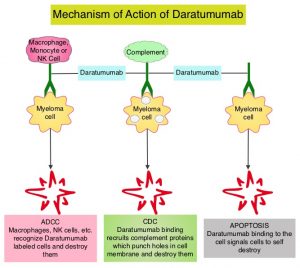SUMMARY: The FDA on December 18, 2020 approved XPOVIO® (Selinexor) in combination with VELCADE® (Bortezomib) and Dexamethasone for the treatment of adult patients with multiple myeloma who have received at least one prior therapy. Multiple Myeloma is a clonal disorder of plasma cells in the bone marrow and the American Cancer Society estimates that in the United States, 32,270 new cases will be diagnosed in 2020 and 12,830 patients are expected to die of the disease. Multiple Myeloma (MM) in 2020 remains an incurable disease. The therapeutic goal therefore is to improve Progression Free Survival (PFS) and Overall Survival (OS). Multiple Myeloma is a disease of the elderly, with a median age at diagnosis of 69 years and characterized by intrinsic clonal heterogeneity. Almost all patients eventually will relapse, and patients with a high-risk cytogenetic profile or refractory disease have the worst outcomes. The median survival for patients with myeloma is over 10 years.
Exportin 1 (XPO1) is an important nuclear export protein overexpressed in multiple myeloma. High XPO1 levels facilitate increased nuclear export of tumor suppressor proteins such as P53, P73, IkB and FOXO3a, pRb, BRCA1, as well as growth regulators such as Glucocorticoid Receptor and oncoprotein mRNA. This enables cancer cells to escape tumor suppressor protein mediated cell cycle arrest and apoptosis. XPOVIO® is an oral selective XPO1inhibitor that reactivates the tumor suppressor proteins by preventing nuclear transport, inhibits oncoprotein translation and reactivates Glucocorticoid Receptor signaling in the presence of Dexamethasone. In a Phase Ib/II study, the combination of XPOVIO® along with VELCADE® (a Proteasome Inhibitor) and Dexamethasone induced high response rates with low rates of peripheral neuropathy.
The present FDA approval for XPOVIO® was based on findings from the BOSTON trial, which is a multicenter, open-label, randomized, controlled Phase III study, conducted to evaluate the clinical benefit of weekly XPOVIO®, VELCADE® (Bortezomib), and Dexamethasone, versus standard VELCADE® and Dexamethasone, in patients with previously treated multiple myeloma. In this study, 402 patients were randomly assigned 1:1 to receive either XPOVIO® 100 mg PO once weekly, VELCADE® 1.3 mg/m2 SC once weekly, and Dexamethasone 20 mg PO twice weekly, or VELCADE® 1.3 mg/m2 SC twice weekly for the first 24 weeks and once weekly thereafter, and Dexamethasone 20 mg four times per week for the first 24 weeks and twice weekly thereafter. The median patient age was 67 years and 32% of the patients had 2 prior lines of therapy, including prior REVLIMID® (Lenalidomide) in 38% and prior VELCADE® in 69%. Approximately 48% of the patients had high-risk cytogenetics which included del(17p), t(4;14), t(14;16) or amp(1q21). The Primary endpoint was Progression Free Survival (PFS), and Secondary endpoints included Objective Response Rate (ORR), Duration of Response (DoR), Overall Survival (OS) and Safety.
It was noted that the median PFS was 13.9 months in the XPOVIO® group and 9.5 months for the control group (HR=0.70; P=0.0075). This represented a 30% reduction in the risk of progression or death with the XPOVIO® triplet combination. This benefit was consistently noted across all subgroups including those with high-risk cytogenetics. The ORR was 76.4% in the XPOVIO® group versus 62.3% in the control group (P=0.0012), and the significantly higher ORR again was noted across subgroups. The median Duration of Response was 20.3 months versus 12.9 months in the XPOVIO® group and the control group, respectively. The most common adverse events in the XPOVIO® group included cytopenias, fatigue, nausea, diarrhea, asthenia, decreased appetite and weight loss.
It was concluded that weekly regimen of XPOVIO® given along with VELCADE® and Dexamethasone, is a novel, effective, and convenient treatment option, for patients with multiple myeloma, who have received one to three prior lines of therapy.
Once-per-week selinexor, bortezomib, and dexamethasone versus twice-per-week bortezomib and dexamethasone in patients with multiple myeloma (BOSTON): a randomised, open-label, phase 3 trial. Grosicki S, Simonova M, Spicka I, et al. Lancet. 2020;396:1563-1573.


